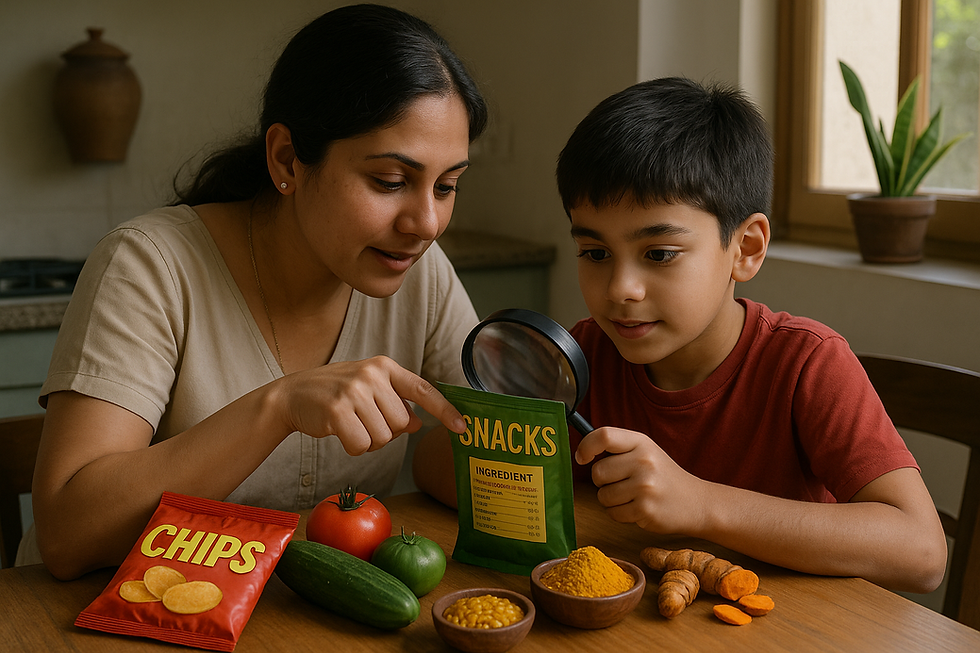How Much Fibre Does Your Child Need?
- Dr Tejal Risbud Rao

- Dec 16, 2024
- 4 min read
Updated: Dec 31, 2024

As a pediatrician, I know how crucial a balanced diet is for a child's health and growth. Fibre plays an essential role in promoting digestion, preventing constipation, and supporting overall well-being. Yet, many parents are unsure about how much fibre their child needs and where to find the right sources, especially within Indian dietary habits.
This guide provides practical insights into fibre requirements for children, tailored to Indian vegetarian and non-vegetarian diets, with tips to incorporate fibre-rich foods easily into meals.
Why Fibre is Essential for Your Child's Health
Fibre is a critical nutrient for children, ensuring smooth digestion and preventing constipation. It helps maintain regular bowel movements, promotes gut health, and balances energy levels, which are essential for growing children.
A fibre-rich diet contributes to:
Healthy Digestion: By improving bowel health and preventing issues like constipation.
Sustained Energy: Ensuring steady energy release throughout the day.
Long-term Well-being: Supporting a balanced gut microbiome and reducing risks of chronic diseases later in life.
Without sufficient fibre, children may experience digestive discomfort and irregular bowel movements. It's vital to understand age-specific needs and include fibre-rich foods daily.
Fibre Needs by Age Group
The amount of fibre a child needs depends on their age, activity level, and growth stage. Here’s a general guide to daily fibre intake:
1–3 years | 14 grams/day |
4–8 years | 20 grams/day |
9–13 years | 25–30 grams/day |
Practical Examples of Fibre Content
Understanding how much fibre common foods provide can make it easier to plan balanced meals for your child. Here are a few examples to guide you:
One apple (medium-sized): Approximately 4 grams of fibre.
One banana (medium-sized): About 3 grams of fibre.
A bowl of spinach (100 grams): Around 2.5 grams of fibre.
A cup of cooked dal (lentils - 200 grams): Contains roughly 15 grams of fibre.
One teaspoon of flax seeds: Provides about 2 grams of fibre.
One teaspoon of chia seeds: Contains approximately 2 grams of fibre.
Factors Influencing Fibre Needs:
Diet diversity: Balanced meals with fruits, vegetables, and grains ensure adequate fibre.
Physical activity: Active kids often need more fibre to maintain gut health.
Tip for Parents: Start small when increasing fibre intake to prevent bloating or discomfort. Add fibre gradually through natural sources like fruits, vegetables, and whole grains.
Recognizing Signs of Low Fibre Intake
It’s essential to watch for signs of fibre deficiency in children, such as:
Constipation: Infrequent or painful bowel movements.
Low Energy Levels: Persistent tiredness due to poor digestion.
Lack of Appetite: Irregular eating patterns caused by digestive discomfort.
If these signs appear, review your child’s diet and consult a pediatrician for tailored advice.
High-Fibre Vegetarian Sources for Indian Children
Whole Grains and Cereals
Examples: Brown rice, whole wheat, oats, millets.
Serving Ideas
Roti or paratha with multigrain flour.
Oats porridge with fruits.
Legumes and Pulses
Examples: Lentils (dal), chickpeas, kidney beans.
Serving Ideas:
Rajma chawal or dal with vegetables.
Chole with roti or rice.
Nuts and Seeds
Examples: Almonds, chia seeds, flaxseeds.
Serving Ideas:
Add chia seeds to yogurt.
Prepare almond-based snacks.
P Fruits: Papaya, Pear, Pineapple, Pomegranate, Prunes
Benefits: Rich in fibre, vitamins, and antioxidants, these fruits promote digestion and prevent constipation.
Serving Ideas:
Papaya: Serve fresh as a snack or in smoothies.
Pear: Slice into fun shapes for lunchboxes or add to salads.
Pineapple: Use in fruit salads or as a refreshing juice.
Pomegranate: Sprinkle on yogurt or as a topping for oats.
Prunes: Include in baked goods or offer as a soft snack for kids.
Tip for Parents: Fresh and seasonal fruits like "P fruits" are an easy, natural way to meet daily fibre needs.
Non-Vegetarian Fibre Options for Indian Children
Fibre-Rich Side Dishes with Non-Vegetarian Meals
Pair chicken, fish, or eggs with high-fibre sides like spinach or broccoli.
Example Meal: Grilled chicken with quinoa and sautéed vegetables.
Meat Substitutes with Added Fibre
Combination Ideas:
Egg curry with whole wheat roti.
Fish curry paired with brown rice and a salad.
Foods to Avoid if Your Child Has Constipation
Certain foods can worsen constipation if fibre intake is already low. Limit:
Refined grains: White bread, pasta, or polished rice.
Sugary snacks: Candies and baked goods.
Excessive dairy: Cheese and full-fat milk without fibre balance.
Building a Balanced Diet with Fibre
Balance fibre with proteins, fats, and other nutrients for holistic growth. Sample meal plan:
Breakfast: Oats with fruits and nuts.
Lunch: Dal with rice, spinach, and salad.
Snack: Yogurt with chia seeds.
Dinner: Whole wheat roti with mixed vegetable curry.
Common Myths About Fibre for Kids
“Too much fibre is harmful”: While excessive fibre can cause discomfort, meeting daily needs supports digestion.
“Fibre is only in vegetables”: Whole grains, nuts, and seeds also offer fibre.
Practical Tips for Parents to Boost Fibre in Meals
Make it Fun: Use cookie cutters to create fun shapes with fruits and veggies.
Blend it In: Add finely chopped vegetables to parathas or dosas.
Snack Smart: Offer nuts, seeds, or fruit yogurt instead of processed snacks.
Takeaway
Providing the right amount of fibre ensures your child’s digestive health and energy levels remain optimal. By incorporating Indian fibre-rich foods into daily meals, you can create a balanced diet that supports growth and prevents digestive issues like constipation.
Need personalized guidance?
The author is a senior Pediatrician and Neonatologist practicing in Bangalore, India. For specific advice on your child’s nutrition, feel free to reach out.
Contact us:
To schedule a one-on-one consultation with one of our in-house experts, please drop an email at happykidspeds@gmail.com. You can also visit our clinic in JP Nagar or book an appointment online.





Comments